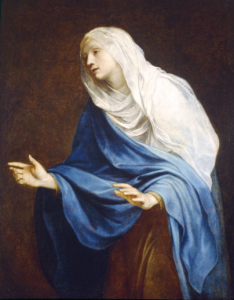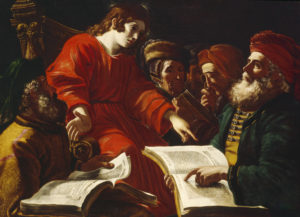Mother of Sorrows (Mater Dolorosa)
Oil on panel
Anthony van Dyck
Flemish, 1599–1641
Baroque art is characterized by its emotional pull. Sotheby’s defines the typical qualities of Baroque art as works with rich colors, strong contrast, luscious brushwork, and subject matter that provokes passion, awe, and reverence. This expressive art movement stemmed from a religious response in the seventeenth century called the Counter-Reformation. Art mimicked life in the emotional appeal for mankind’s souls; Biblical stories were taken beyond quiet, respectful meditation and became captured “moments” of heightened drama. Still, there are a handful of Baroque works in existence that balance this emotion with restrained contemplation. One of which is the Museum & Gallery’s Mother of Sorrows by Antony van Dyck.
Anthony van Dyck (1599-1641) is considered one of the great Flemish painters of the seventeenth century. A child prodigy, van Dyck became connected with another great Flemish artist, Peter Paul Rubens, and worked alongside the master on many important commissions. Van Dyck became known for his portraits, and his talent opened doors for him in many courts of Europe. With an extensive and prestigious curriculum vitae painting clients in all their luxury and refinement, van Dyck’s Mother of Sorrows is a unique contrast.
The Mother of Sorrows or Mater Dolorosa depicts Mary grieving her dead Son. It was developed from the theme of the Virgin of the Seven Sorrows, which showed each anguish she experienced after the birth of Christ. In the sixteenth century, Mary’s mourning was usually represented alongside Christ, the Man of Sorrows. However, by the late sixteenth and seventeenth centuries in Northern Europe, artists began depicting Mary alone against an undefined background to highlight the emotion of a bereaved mother. When this work was created circa 1625-1630, van Dyck had spent time in Italy and created many historic and religious works focused on main characters in their own narrative. Unlike Rubens, van Dyck did not clutter the canvas with various other characters or subject matter, instead focusing on the psychology of the main subject.
In M&G’s Mother of Sorrows, van Dyck explores the emotion of one of the world’s most famous mothers. Mary, the mother of Jesus Christ, stands alone against a dark background. The contrast is so great she seems to glow under the intense chiaroscuro. The rich blue fabric softens the stark white veil, but also stands as a symbolic reminder of Mary’s virginity and status as the mother of the King of Kings. While not overwhelming in emotion compared to other contemporary interpretations, one can tell she is hurting. She leans forward with arms raised as if pleading. There is pentimenti, or earlier painting that has been covered over by the artist. Just under Mary’s outstretched hand is a faint remnant of a previously lower hand positioning. Art historians such as Gustav Gluck and Ludwig Burchard both agree this was created by van Dyck. It is believed that van Dyck did not spend more than one hour on each portrait. This leads the viewer to wonder why the artist adjusted the hand’s placement. Perhaps a lowered hand did not express the right amount of grief. Or perhaps a more uplifted hand shows Mary’s reliance on God in her darkest hour.
This work may not hold the same prestige as other van Dyck paintings. In fact, until 1864, it had been rather unknown since it was relatively inaccessible in a collection in St. Petersburg, Russia. However, it is a beautiful and rare work in van Dyck’s oeuvre. Gluck and Burchard applauded van Dyck’s color (which was heavily influenced by his time in Venice), his hand forms, and his portrayal of deep emotion. Gluck wrote, “the expression of the grieving face—a depth of feeling which is rare to the master’s work,” is a testament to how unique this painting is for its time. Viewers can resonate with this strong emotional moment of a grieving mother and reflect on one of the darkest moments in history, while also knowing the story does not end there.
KC Christmas Beach, M&G summer art educator
Published 2023


